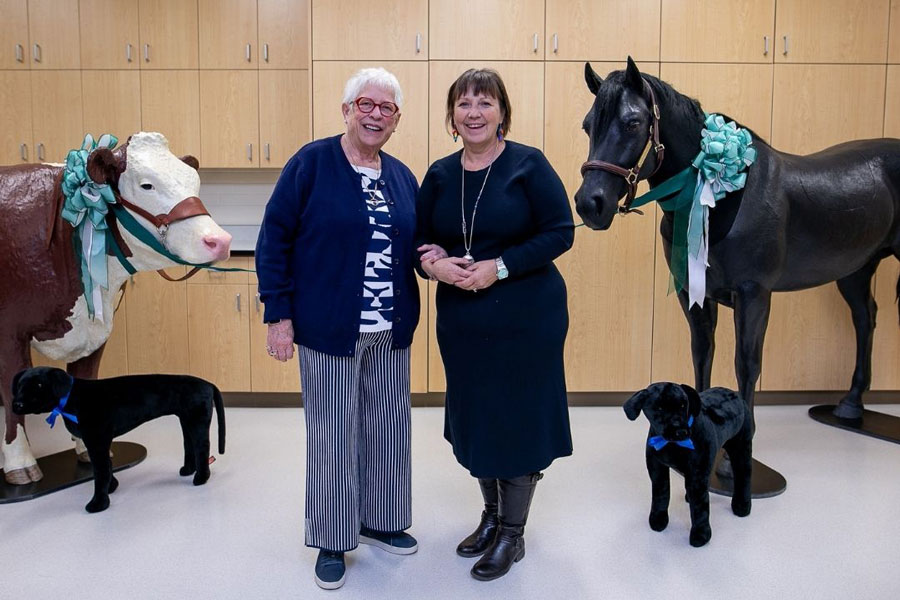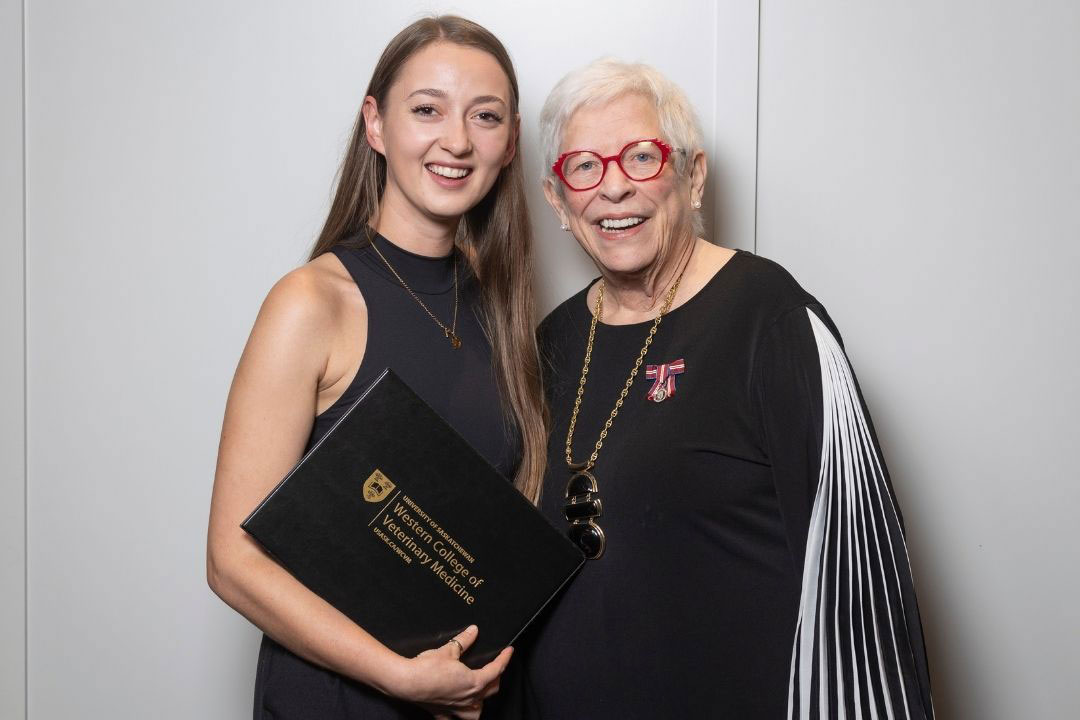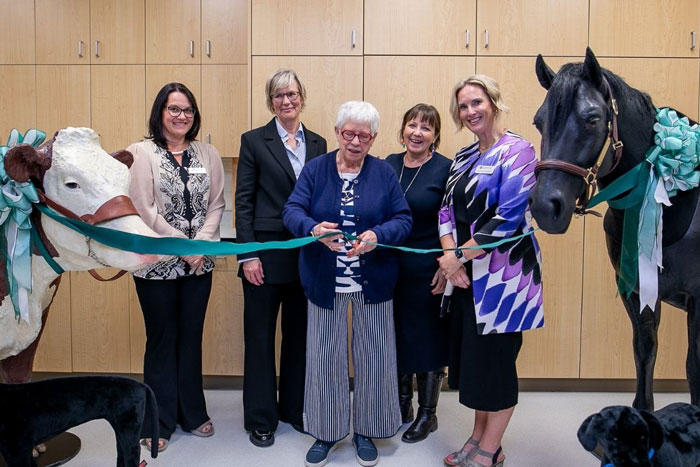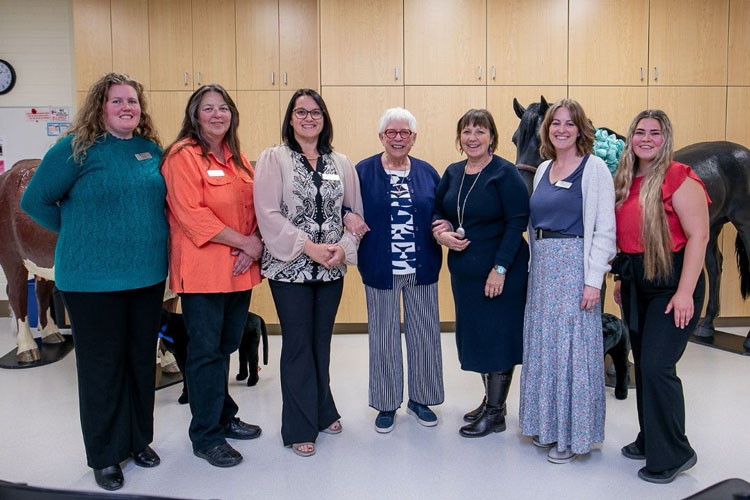
‘Let’s get started’: Bev Hughes’ legacy in veterinary medicine education
When Bev Hughes takes her dog Tyme in for appointments at her local veterinary clinic, she always asks the attending veterinarian one question: “Where did you go to veterinary school?”
By Rigel Smith“I always make sure they're from the Western College of Veterinary Medicine,” says Hughes, a Calgary businesswoman and philanthropist. “I wouldn't go to anybody else.”
Hughes has always loved animals. But it was a particular calico cat, Tessie, that put her on the path to supporting the Western College of Veterinary Medicine (WCVM).
Tessie, who was adopted as a kitten from a flower shop, lived a long and happy life in the country with Hughes and her family. When Tessie faced medical issues in her later years, Hughes knew it was time to humanely euthanize her. She turned to Dr. Susan Ambrose (DVM), a local veterinarian and a WCVM graduate, to perform the procedure at home — a decision that left a lasting impression.
“I just thought so much of that, to be able to do it in our own environment,” says Hughes. “I was so pleased with Dr. Ambrose, who went to our vet college here, that I started a scholarship in her name.”

Since its inception in 2009, this generous scholarship has annually recognized a third- or fourth-year veterinary student who intends to pursue an entrepreneurial career in small animal health care. The award, which is now known as the BJ Hughes Scholarship, covers the combined value of both tuition and student fees for one academic year. The 2024 recipient of the scholarship was Samantha Fontaine, a third-year veterinary student from Cooks Creek, Man.
But Hughes’ support of the college didn’t stop there.
In 2016, she took a trip to the WCVM to investigate new ways to contribute. During her trip to the University of Saskatchewan (USask), she was introduced to the Clinical Learning Resource Centre (CLRC) in the new Health Sciences building on campus. Focused on different aspects of human health training, this centre features a variety of simulation tools including mannequins that can be programmed to simulate health issues such as heart attacks, strokes, labour and delivery, and more.
“It was the most impressive thing I've ever seen in my life,” says Hughes. “I never knew such a thing existed. I asked Dean Freeman (Dr. Doug Freeman, the WCVM’s former dean) if we could take this [approach] over to the vet college, and he said, ‘Yes, we could.’ So I said, ‘Okay, then let’s get started.’”
Her vision led to the establishment of the BJ Hughes Centre for Clinical Learning, a high-tech clinical skills laboratory that enables veterinary students to practise their clinical skills in a safe learning environment. Her initial investment, along with support from the BJ Hughes Foundation, covered $340,000 of the facility’s total cost of $500,000 to build and supply the centre that officially opened in 2016.

During a special ceremony on September 23, the WCVM and USask honoured Hughes for her extraordinary generosity. In the past 15 years, Hughes has donated over $1.29 million to the WCVM — supporting both the BJ Hughes Centre for Clinical Learning and her annual student scholarship at the veterinary college. The event celebrated her lasting impact on the college and her unwavering dedication to enhancing the learning environment for future veterinarians.
“I'm 80 years old now and the older you get the more important legacies are,” says Hughes, who attended the ceremony in Saskatoon. “I really thank the college — they've been great.”
Dr. Gillian Muir, the college’s dean, says Hughes’ contributions to the college have been significant.
“It’s hard to believe it was really only eight years ago that the centre opened because it has become such an integral part of who we are and what we do in this college,” says Muir. “It’s the generosity of Bev Hughes that allowed us to set this up.”
The centre’s manager — and its very first staff member — is Carolyn Cartwright, a registered veterinary technologist and veterinary technician specialist in anesthesia and analgesia.
“When I first started, there wasn’t anything in there — no chair, no computer, not even a pen,” says Cartwright. “Now we have a full staff, tons of models, and we've grown from [providing] just a few labs to over 700 labs [per academic year].”
In the past eight years, Cartwright has witnessed how the centre has played a growing role in supporting and delivering veterinary education. Like other North American veterinary colleges, the WCVM’s revised curriculum is based on competency-based veterinary education (CBVE) — a new approach that was introduced just when the BJ Hughes Centre for Clinical Learning was created. Like the model used to train human physicians, this outcomes-based approach focuses on developing entry-level clinical competencies required for veterinary practice.
The centre offers a wide variety of resources — from high-fidelity canine and feline training models to full-sized horse and cow models — that are all designed to give students the chance to develop their skills in a safe, controlled environment. Students from all four years of the Doctor of Veterinary Medicine (DVM) program complete labs in the centre with teaching staff and have access to “take home” simulation kits for additional practice. Training is also offered to clinical interns, residents and graduate students who want to enhance their skills.
“It's a safe environment and it’s a non-judgmental environment,” says Cartwright. “They can repeat skills until they’re comfortable, so it gives them confidence once they go to that live patient.”

The centre's benefits extend beyond WCVM — staff are often busy conducting animal health demonstrations at public events or helping to provide education and training to a variety of students and youth groups.
One popular attraction is Agnes, the centre’s bovine calving model. Agnes is a full-size cow, complete with an anatomically correct uterus, a working udder and a full-size calf. It’s designed to teach both students and the public about the steps involved in calving and caring for a newborn calf. The calving simulator also allows veterinary students and producers to practise skills and strategies for dealing with difficult calving situations.
The WCVM teamed up with the Canadian Western Agribition and the Government of Saskatchewan to purchase Agnes in 2017, and since then, the model has become a staple at Agribition as well as other community and agricultural events.
“The education component goes well beyond the college — it’s a community initiative,” says Cartwright. “It’s such an honour to be able to showcase the centre and all it has.”
As for the future of the BJ Hughes Centre, both Hughes and Cartwright are enthusiastic about its continued growth. Hughes sees this as just the beginning.
“I want this centre to be the world-renowned centre for this type of training,” says Hughes. “It's good now, but I want to go from good to the very best — that's really my objective.”
Cartwright shares Hughes' vision for the future.
“The opportunities are endless — not only for the students, but for the interns, residents and instructors who are here,” says Cartwright. “We’ve really elevated our teaching program in a big part due to simulation, and we have Bev to thank for that.”
As the legacy of the BJ Hughes Centre for Clinical Learning continues to shape the future of veterinary medicine, Hughes is now connecting with a new generation of veterinarians. During a recent trip to her vet clinic in Calgary, Hughes learned that the new veterinarian who was examining her dog was a WCVM graduate.
When Hughes asked if she had trained at the BJ Hughes Centre for Clinical Learning, the veterinarian’s response was enthusiastic: “Yes, we used it all the time! Why do you ask?”
After a brief pause, the young vet looked at Hughes and said, “I know — you’re BJ Hughes, right?”
It’s a moment that Hughes won’t soon forget.
“I was very proud of that moment,” says Hughes. “Everything came full circle."
Article originally published at https://wcvmtoday.usask.ca
Together, we will undertake the research the world needs. We invite you to join by supporting critical research at USask.


